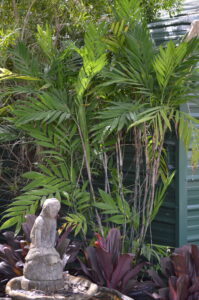S & J Nurser’s guide to Growing
Hardy Bamboo Palm
/ Chamaeodora microspadix
in the Jacksonville | St. Augustine area Landscape
 Hardy Bamboo Palm Origins:
Hardy Bamboo Palm Origins:
– Chamaedorea microspadix is native to the forests of Mexico and is well suited to Florida’s hot and humid climates.
Hardy Bamboo Palm Preferred Exposure:
– Full shade is preferable in the North Florida landscape although plants may acclimate themselves over time to a partial shade / sun garden location.
Hardy Bamboo Palm Fronds | Trunk:
– Foliage of the Hardy Bamboo Palm remains evergreen through light frosts and is surprisingly cold hardy I the North Florida | Jacksonville and St. Augustine area landscapes, they have been known to take frosts down to 18 degrees but can damage with severe or prolonged freezing temperatures.
– Small slender stems with large soft fronds give this plant its common name as it resembles the foliage and stems of bamboo plants.
Hardy Bamboo Palm Preference / Salt tolerance:
– Chamaedorea microspadix palms planted in the North Florida | Jacksonville | St. Augustine landscape will tolerate virtually any soil condition, but will prefer a well drained site.
– Salt tolerance is poor
Hardy Bamboo Palm Size Variance:
– Xhamaedorea microspadix palms can reach sizes of 5-8 feet H | and spreading 3-5 feet in width.
Hardy Bamboo Palm Growth Habit:
– Chaaemdorea microspadix has a narrow upright growth habit being much taller than wide. New stems pop up from the root system at the from the base of the palm, forming a clump of bamboo like stems and foliage.
Hardy Bamboo Palm Growth Rate:
– Hardy Bamboo Palm trees are slow to moderate growers.
Hardy Bamboo Palm Bloom:
– White clusters give way to bright orange – red fruits that persist on the plant adding to its appeal. Very showy fruits!
Hardy Bamboo Palm Water Requirements:
– Drought tolerant for short periods of time.
Best Uses For Hardy Bamboo Palm in the North Florida | Jacksonville | St. Augustine
landscape:
– Chamaedorea microspadix is an excellent choice for an evergreen shade palm in smaller landscapes or porches and patio areas where excessive growth would be problematic.
– Perfect understory planting under large oaks or established trees for an
instant tropical effect.
– Great container plant.
Care of Hardy Bamboo Palm / Chamaedorea microspadix:
– Hardy Bamboo Palm will need good water during the establishment period and are drought tolerant once established into the landscape.
– Trim back damaged or older browned out fronds each year in early spring at the base of the stem to keep the plant at its best.
MINIMUM PALM FERTILIZER REGIMEN – what you should be going to keep your palm healthy
– Fertilize each spring with a specially blended fertilizer for Palms, follow
manufacturers directions and apply 1/2 lb o 1lb of fertilizer per inch of diameter of trunk on your palm, measured from a hands width above the ground level. That means for a 12 inch wide trunk from left to right you
would need 6-12 lbs of fertilizer for just that one palm!
– Fertilize every fall with magnesium sulfate ( Epsom Salt) to keep your palm green and healthy through the winter months!
MAXIMUM PALM FERTILIZER REGIMEN – what you can do to get your palm up and growing Fast!
– Fertilize every three months with your choice of Palm fertilizer and
Magnesium Sulfate. Water 3-4 times per week and make sure to water thoroughly after each fertilizer application.
– Wait till fronds have turned completely brown before removing from the palm as the palm will take back in the nutrients from those older leaves and use it when forming new ones.
*CAUTION – DO NOT FERTILIZE NEWLY PLANTED /
TRANSPLANTED
FIELD GROWN PALM TREES WITH PALM
FOOD!
Note : When planting smaller
palms being grown in a container, this rule does not apply, rather, use half the recommended application rate
for your trunks diameter, as container grown palms roots have not been damaged or cut during planting but are still only a portion as large as they would be if the palm had been growing in the ground and excess fertilizer on a
confined root system is still not preferable for maximum health.
Palm fertilizers are water soluble and will burn the new roots your palm tree is trying to put out as it establishes itself into the landscape. It is best to use only poly coated plant food that is heat release like Osmocote general purpose fertilizer or non burning Milorganite in the first year in the landscape, and then the following year, start your palm food regimen that will provide all of the minor nutrients that your palms will need to keep them healthy and problem free in Florida’s soils.

